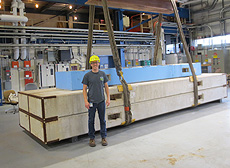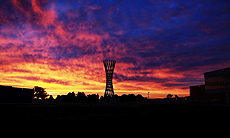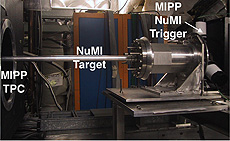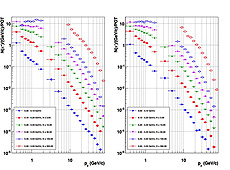|
Friday, Sept. 26
- Breakfast: breakfast turnover
- Breakfast: chorizo and egg burrito
- Beer-braised bratwurst
- White fish florentine
- Liver and onions
- Baked ham and cheese ciabatta
- Boneless wing bar
- Wisconsin beer and cheese soup
- Texas-style chili
- Assorted pizza by the slice
Wilson Hall Cafe menu
|
|
Friday, Sept. 26
Dinner
- Cold cucumber soup
- Linguine with clam sauce
- Sauteed asparagus spears
- Lemon blueberry cake
Wednesday, Oct. 1
Dinner
Menu unavailable
Chez Leon menu
Call x3524 to make your reservation.
|
|
One minute with Jared Gaynier, mechanical engineering undergraduate
 |
| Jared Gaynier, member of the AD Mechanical Support Department, is an engineering co-op student. Here he stands by hoist ring base and blocks prior to conducting a load test. Photo: Christine Ader, AD |
What is your title here and what program are you with?
I am an "engineering co-op" — part of the Cooperative Education Program at Fermilab — with the Accelerator Division Mechanical Support Department. I study mechanical engineering at Kettering University in Michigan for two quarters, and I come here for the summer and winter quarters. I began at Fermilab the summer of 2011, and I finish this Friday, Sept. 26.
And then what will you do?
I have one more quarter at Kettering. Then I am going into the Navy as a surface warfare officer. I am in the Nuclear Propulsion Officers Candidate Program, somewhat similar to ROTC.
How did you find out about Fermilab's cooperative education program?
In high school in Ida, Michigan, I wrote a report on Enrico Fermi and learned about Fermilab then. In my first term at Kettering University, my chemistry professor started off the class talking about neutrinos and Fermilab, so that brought it back to me. That semester, I researched more about Fermilab on the website and found out they had a co-op program and applied.
What did you do here on a daily basis?
Basically, when engineers or physicists — mainly in the Accelerator Division — request mechanical support, I am there to help. One day I could be down in the tunnel helping taking measurements or installing fixtures, or I could be at my desk making 3-D models or doing computer simulations.
What has been the most enjoyable part for you at Fermilab?
I'd say interacting with all the different people around the lab. There are a lot of very intelligent, sharp individuals here, from all different backgrounds.
How do you think the Navy will fulfill your hopes?
Well, I like adventure, so traveling around the world on an aircraft carrier is going to be really cool. Also, professionally, it is going to be a leadership experience. I am going to be on a ship with a bunch of other people for a long period of time, and I really enjoy a close-knit community. It is something I have at school. And it is something I have here at Fermilab — it is a very close-knit community here, too. I look forward to that in the Navy.
—Rich Blaustein
|
Early light
 |
| Fiery hues of Thursday's sunrise fill the sky above "Tractricious." Photo: Greg Vogel, AD |
|
October wellness offerings, fitness classes and discounts
Health and Wellness Fair
Tuesday, Oct. 14, 11:30 a.m.-1:30 p.m.
Wilson Hall atrium
Vendors, giveaways, drawings, complimentary chair massages and spinal screenings
Fitness Classes
Yoga Mondays
Mondays, Oct. 6-Nov. 10
noon-12:45 p.m.
WHGFE Training Room
Fee: $45. Register by Sept. 29.
Yoga Thursdays
Thursdays, Oct. 9-Nov. 13
noon-12:45 p.m.
WHGFE Training Room
Fee: $45. Register by Oct. 2.
Ultimate Core
Wednesdays, Oct. 22-Nov. 26
11:45 a.m.-12:30 p.m.
Fitness Center Exercise Room
Fee: $60. Register by Oct. 15.
Zumba Toning
Tuesdays, Oct. 21-Nov. 25
11:45 a.m.-12:30 p.m.
Fitness Center Exercise Room
Fee: $40. Register by Oct. 14.
Zumba Fitness
Thursdays, Oct. 23-Nov. 20
11:45 a.m.-12:30 p.m.
Fitness Center Exercise Room
Fee: $35. Register by Oct. 16.
Athletic League
Indoor soccer
Tuesdays and Thursdays, 6-9 p.m.
Fitness Center Gym.
Gym membership required. Contact O'Sheg Oshinowo for more information.
Employee Discount
Six Flags Fright Fest
Weekends, Sept. 27-Nov. 2
For more information on this and other discounts, visit the Employee discounts Web page
|
Chaos and order meet in 'Negentropy' exhibit at Fermilab
From Daily Herald, Sept. 24, 2014
The Fermilab Art Gallery presents "Negentropy," with paintings and etchings by Renee Robbins and Bruce Riley. It is on display through Dec. 26. A reception to meet the artists will be held from 5 to 7 p.m. Friday, Sept. 26, in the gallery on the second floor of Wilson Hall, off Kirk Road and Pine Street in Batavia. It is free and open to the public.
A gallery talk will be offered at noon Wednesday, Oct. 15, in the gallery. To register for the Gallery Talk, email Georgia@fnal.gov.
The Fermilab Art Gallery is a space for art exhibitions, chamber music concerts and where the top quark and big bang are debated over coffee. It is also a quiet space for contemplation and beauty. The gallery is open from 8 a.m. to 4:30 p.m. weekdays. Sign in at the Wilson Hall atrium reception desk.
Read more
|
|
How many protons does it take to make a neutrino?
 |
| The NuMI target is mounted in Fermilab's MIPP experimental hall. |
The Neutrinos at the Main Injector beam facility, known as NuMI, was built at Fermilab so that scientists could have a tunable source of neutrinos with which to conduct experiments. The NuMI beam has been a fantastic success, leading to important measurements made by the MINOS, MINERvA and other experiments. The beam has now been "retuned" to optimize the sensitivity of the NOvA experiment, which expects to have first neutrino oscillation results in 2015.
The NuMI beam is produced by smashing more than 10 million million high-energy protons extracted from the Main Injector accelerator into a specially designed graphite target every couple of seconds. The protons break apart the nuclei of the carbon atoms in the graphite, producing short-lived pions and kaons. Some of these newly produced particles escape the target and decay into muons and neutrinos. The muons are absorbed in the underground rock, but the neutrinos stream right through the rock and form the NuMI beam.
So just how many neutrinos does Fermilab produce at the NuMI beam facility? This seemingly simple question has not been so easy for scientists to answer. It is also an important question, since some measurements using the NuMI beam require reliable, precise knowledge of the number of neutrinos passing through their detectors. This number is known as the neutrino flux. Attempts to measure the neutrino flux directly are complicated by the fact that the neutrino properties known as cross sections needed to determine the flux have large uncertainties.
Instead we rely on computer simulations of many millions of proton interactions in the NuMI target to predict the neutrino flux. But these simulations require precise knowledge of how proton, pion and kaon particles — the neutrino parent particles — are produced when they interact with the target material, and there are rather large uncertainties on particle production. As a result, the neutrino flux uncertainties are three to five times larger than any other uncertainty in neutrino cross section measurements.
In order to improve the neutrino flux prediction, the MIPP (Main Injector Particle Production) collaboration counted the number of neutrino parents produced using an actual NuMI target (shown installed in the MIPP experimental hall in the above picture) and recently released results of charged-pion production yields as a function of pion momentum. The results, shown below, have been published in Physical Review D.
These data may be directly compared to the results of the computer simulations used by all NuMI experiments, and preliminary studies indicate significant differences between the simulation and the data. More importantly, the newly released MIPP data provide an opportunity to directly correct the simulation of pion production off the NuMI target with data collected in a matching configuration. Several NuMI-based experiments, including MINERvA, MINOS and NOvA, are investigating ways in which to make best use of these important data from MIPP.
In the near future it is expected that the MIPP data will help significantly reduce NuMI flux systematic uncertainties, making NuMI the world's best understood accelerator neutrino beam and making Fermilab the place to do neutrino physics.
—Jonathan Paley, Argonne National Laboratory
Learn more
 |
| Pion yields per proton on target as a function of longitudinal momentum (pz) in steps of momentum in the transverse direction (pT). Different colors and markers represent steps of pT, and the yields are scaled such that the points in different pT steps do not overlap. |
|
FIRUS system upgrades to affect alarm system sitewide
The FIRUS system will undergo a software upgrade and system testing on Saturday, Sept. 27, from 9 to 11 a.m. This means that the FIRUS system will be offline during this time. It will not notify the Fermilab communication center of active fire-security-utility local alarms. The local building fire alarm systems and other independent emergency systems, including smoke detection, sprinkler systems, flammable gas alarms, pull stations and ODH alarms, will work locally.
In the event of a fire, occupants should follow the building's emergency plan by activating a pull station, evacuating the building and calling x3131 from a Fermilab office phone or 630-840-3131 from a mobile phone.
|
|